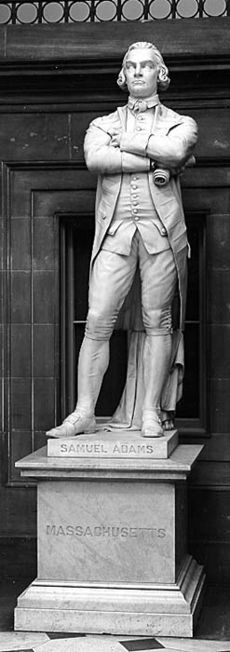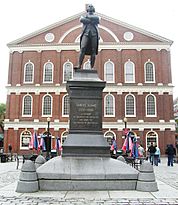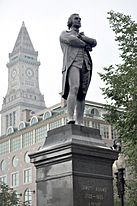Samuel Adams (Whitney) facts for kids

Samuel Adams was an important leader during the American Revolution. He helped the colonies gain independence from British rule. A talented artist named Anne Whitney created two famous statues of him. One statue was made in 1876 and is in the National Statuary Hall Collection inside the U.S. Capitol building in Washington, D.C.. The second statue was finished in 1880. You can find it in front of Faneuil Hall Plaza in Boston.
Samuel Adams Statue in the U.S. Capitol
The U.S. Congress asked each state to send two statues of important people to the nation's capital. These statues would be displayed in the National Statuary Hall Collection. Many people thought John Adams, Samuel's cousin and a future president, should be chosen. However, Samuel Adams was the most popular historical figure in Massachusetts at that time. He wrote many letters to leaders and newspapers. Some even called him "the most persuasive political writer of all time."
Anne Whitney won a competition in 1873 to create the statue of Samuel Adams. One rule was that the statue had to be carved in Italy. It would be made from a plaster model created in Boston. Whitney traveled to Italy in 1875 to get Carrara marble for the sculpture. The finished statue was sent to Washington, D.C., in 1876. This was a special year because it was the country's 100th birthday!
There's a famous story about Anne Whitney. She once won a contest to create a statue of Charles Sumner. But when the judges found out she was a woman, they changed their minds. A poem was published in the New York Evening Telegram about this. It said that even though a woman carved the Samuel Adams statue, it was still "grandly human." The statue was officially shown in the Capitol on December 19, 1876.
Samuel Adams Statue at Faneuil Hall
Before the marble statue went to Washington, D.C., it was shown at the Boston Athenæum. People in Boston loved it so much! Because of this, the citizens of Boston asked Anne Whitney to make a bronze version for their city.
The bronze statue was placed on a granite base in 1880. It stands on Congress Street in Faneuil Hall Plaza in Boston. This is a very important spot! Samuel Adams used to give powerful speeches here about British rule and unfair taxes. This bronze statue looks very similar to the marble one in the Capitol.
The statue shows Samuel Adams looking determined and ready to stand up for what's right. His arms are crossed, showing his defiance against British rule. His face is carefully carved, and he wears the everyday clothes of his time. Samuel Adams was a true patriot. He helped start the Sons of Liberty with John Hancock. This group protested against unfair taxes on the colonists.
The statue shows Adams at a key moment. After the Boston Massacre, he demanded that Governor Thomas Hutchinson remove British troops from Boston. The troops were then moved to Castle Island in Boston Harbor.
The words on the monument tell us more about him: "Samuel Adams 1722–1803 – A Patriot – He organized the Revolution, and signed the Declaration of Independence. Governor – A True Leader of the People. Erected A. D. 1880, from a fund bequeathed to the city of Boston by Jonathan Phillips. A statesman, incorruptible and fearless."
The statue stands on a tall pedestal, about ten feet high. The base is made of polished Quincy granite. Below that is a larger, unpolished granite base. The ground around the statue also has interesting details. Lines etched into the granite show where the shoreline was around 1630. Different colored granite slabs show old street layouts from an 1820 map. This artwork is called A Once and Future Shoreline. It includes etched pictures of seaweed, fish, and shells.
The statue first stood in Adams Square. It was moved later when the Government Center was built.



